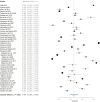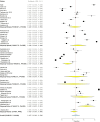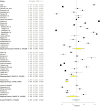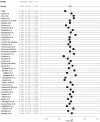Prevalence of Dental Caries and Associated Factors in East Africa, 2000-2020: Systematic Review and Meta-Analysis
- PMID: 33996722
- PMCID: PMC8116500
- DOI: 10.3389/fpubh.2021.645091
Prevalence of Dental Caries and Associated Factors in East Africa, 2000-2020: Systematic Review and Meta-Analysis
Abstract
Background: Dental caries affects mastication, growth and development, and school attendance and has a long-term psychological effect on affected individuals. In developing countries, the prevalence of dental caries is increasing due to the growing consumption of sugary foods, poor tooth brushing habits, and a low level of awareness about dental caries. Even if there was a high prevalence of dental caries in sub-Saharan Africa, there is a paucity of data on the prevalence of dental caries in East Africa. Hence, this study aimed to determine the prevalence of dental caries and associated factors in East Africa. Methods: A systematic search of articles was conducted in MEDLINE, Scopus, and Google Scholar using all the synonyms of dental caries in published literature (until December 2020) in East Africa. Important data were extracted using a standardized data extraction form prepared in Excel. Stata software (version 14.0) was used to calculate the pooled prevalence of dental caries. Besides, subgroup analysis was done based on country and dentition type. Moreover, associated factors of dental caries were assessed and the overall effect was presented in the form of odds ratios. The quality of the included studies was evaluated using the Joanna Briggs Institute reviewers' manual. Results: The overall pooled prevalence of dental caries was found to be 45.7% (95% CI = 38.0-53.4). The pooled prevalence was high in Eritrea (65.2%, 95% CI = 49.2-81.1), followed by Sudan (57.8%, 95% CI = 36.0-79.7), and a low prevalence was found in Tanzania (30.7%, 95% CI = 21.5-39.9). Moreover, the subgroup analysis revealed a prevalence of 50% (95% CI = 38.4-62.1) in permanent dentition and 41.3% (95% CI = 33.5-49.2) in mixed dentition. The overall mean decayed, missed, and filled permanent (DMFT) and primary (dmft) teeth were 1.941 (95% CI = 1.561-2.322) and 2.237 (95% CI = 1.293-3.181), respectively. High DMFT scores were reported in Sudan (3.146, 95% CI = 1.050-5.242) and Uganda (2.876, 95% CI = 2.186-3.565). Being female (OR = 1.34, 95% CI = 1.24-1.46) and having poor tooth brushing habit (OR = 1.967, 95% CI = 1.67-2.33) were independent risk factors of dental caries. Conclusion: The overall prevalence of dental caries was comparatively high. Being female and poor oral health practice were independent risk factors of dental caries. The Ministry of Health of the member countries, along with dental associations of each country, ought to offer due attention to strengthen the oral health program in schools and primary health care centers and the implementation of school water fluoridation.
Keywords: DMFT; dental caries; oral health; prevalence; tooth decay.
Copyright © 2021 Teshome, Muche and Girma.
Conflict of interest statement
The authors declare that the research was conducted in the absence of any commercial or financial relationships that could be construed as a potential conflict of interest.
Figures









References
-
- Maher R, Khan A, Rahimtoola S, Bratthall D. Prevalence of mutans streptococci and dental caries in Pakistani children. JPMA J Pak Med Assoc. (1992) 42:213–5. - PubMed
-
- Tinanoff N, Kanellis MJ, Vargas CM. Current understanding of the epidemiology mechanisms, and prevention of dental caries in preschool children. Pediatr Dent. (2002) 24:543–51. - PubMed
Publication types
MeSH terms
LinkOut - more resources
Full Text Sources
Other Literature Sources
Medical

